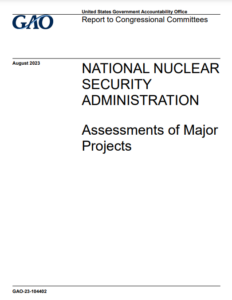The OurEnergyLibrary aggregates and indexes publicly available fact sheets, journal articles, reports, studies, and other publications on U.S. energy topics. It is updated every week to include the most recent energy resources from academia, government, industry, non-profits, think tanks, and trade associations. Suggest a resource by emailing us at info@ourenergypolicy.org.
Resource Library
As the Paris Agreement calls for net-zero pathways for all sectors, new and innovative decarbonization technologies are actively being developed across the concrete production value chain. This is a dramatic paradigm shift for the concrete and cement industry. It has been traditionally innovating to optimize for consistent quality, lower costs and higher performance, but now must also look to optimize for lower carbon in cement and concrete. The readily available technologies alone will not get us to net zero. The development and deployment of emerging technologies are necessary for the sector’s decarbonization pathway.
The time is now to invest in …
View Full ResourceMicrogrids have the potential to provide customers with clean, low-cost, and most critically, resilient power. SEPA hosted a briefing for Microgrid Controller Standards IEEE 2030.7© and IEEE 2030.8© to provide an overview of the standards and explore the challenges and next steps for microgrid standards. The briefing focused on the adoption and testing associated with IEEE 2030.7© or IEEE 2030.8© by providing:
-
An update on the newest version of these standards
A review of potential gaps in the testing standard (IEEE 2030.8©), and
A look at potential future work or development the discussion group hopes to see
The Framework for Greenhouse Gas Emissions Reduction Planning: Industrial Portfolios articulates a process to help industrial organizations develop a specific, actionable plan to achieve Scope 1 and Scope 2 greenhouse gas (GHG) emissions reduction – an Emissions Reduction Plan (ERP). An ERP covers an entire portfolio of facilities, yet contains enough detail to be practically useful at the facility level.
Organizations may find many benefits to developing an ERP. An ERP translates targets into action and ensures members of an organization at all levels understand the resources needed to achieve goals.
The Framework guides organizations through five milestones to developing …
View Full ResourceWind power additions in the United States totaled 8.5 gigawatts (GW) in 2022. Wind power growth has historically been supported by the industry’s primary federal incentive—the production tax credit (PTC)—as well as myriad state-level policies. Long-term improvements in the cost and performance of wind power technologies have also been key drivers for wind additions. Nonetheless, 2022 was a relatively slow year in terms of new wind power deployment—the lowest since 2018—due in part to ongoing supply chain pressures, higher interest rates, and interconnection and siting challenges, but also the reduction in the value of the PTC that was in place …
View Full ResourceThe report presents a framework for states that seek to incorporate equity into regulatory decision-making. Berkeley Lab contextualizes approaches and metrics from various states into example processes to exemplify how this may be done, including topics such as the development of equity goals and definitions, intervenor funding, community engagement, performance-based ratemaking, and utility resource planning. The report offers five takeaways and considerations, supported by these examples:
Equity comprises multiple tenets and stages, all of which must be considered in parallel. At the start of designing new equity-related processes, it is critical to establish clear and actionable goals, definitions, roles, and … View Full Resource“All Electric Construction: A Good Deal” details the cost saving opportunity for constructing new homes to be all-electric and avoiding gas pipeline extensions.
All-electric building codes lead to lower construction costs in Texas by encouraging developers to bypass the cost and complexity of installing new gas lines. These homes have roughly the same utility bills as mixed-fuel homes, which use both gas and electricity. Those savings are projected to improve over time as gas prices rise.…
Since federal clean energy incentives were passed last year, signs of rapid growth for maturing American clean energy industries are emerging. U.S. wind manufacturing plants that closed in recent years are bringing back workers. Plans for an unprecedented amount of new solar, battery, and offshore wind plants are being drawn and developed. The U.S. is in a position to secure our energy independence and become a global leader in the buildout of clean energy.
The new incentives offer companies significant opportunity to invest in new utility-scale wind, solar, and storage projects and manufacturing facilities, while passing on savings to American …
View Full Resource“Renewable Gas: Not A Climate-Aligned Solution for Buildings” covers biogas and synthetic gas and why neither are viable alternatives to building electrification.
Electrification is the most viable option to fully decarbonize New York’s buildings. Alternative fuels like renewable gas are more expensive, limited in supply, and can still cause significant environmental and health impacts. New York must plan to transition away from existing gas infrastructure as part of its clean energy strategy.…
NNSA—a separately organized agency within DOE—plans to invest tens of billions of dollars in major construction projects to modernize the research and production infrastructure on which the nuclear weapons stockpile depends. Major projects are those with an estimated cost of $100 million or more. House and Senate reports include provisions for GAO to periodically review these projects. This report assesses (1) the performance of NNSA’s portfolio of major projects in the execution phase that have cost and schedule baselines and (2) the development and maturity of project designs and critical technologies for projects in the earlier definition phase that do …
View Full Resource“All Electric Construction: A Good Deal” details the cost saving opportunity for constructing new homes to be all-electric and avoiding gas pipeline extensions.
All-electric building codes lead to lower construction costs in New York by encouraging developers to bypass the cost and complexity of installing new gas lines. These homes have roughly the same utility bills as mixed-fuel homes, which use both gas and electricity. Those savings are projected to improve over time as gas prices rise.…









